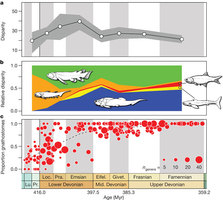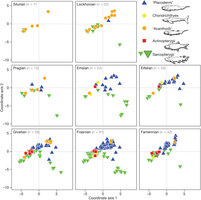摘要:地球上第一批有颌脊椎动物的数量远远少于无颌脊椎动物的数量。今天,99%以上的脊椎动物都是有颌的。因此,我们很容易得出这样的结论:颌的演化是脊椎动物数量增加的关键。但据对早期有颌脊椎动物的下颌骨所做的一项定量生物力学分析,问题也许要更为复杂。Anderson等人发现,早期有颌脊椎动物的颌骨有很多形式,但早在无颌脊椎动物数量下降之前就只剩下几种比较可靠的保守形式了。
生物探索推荐英文论文摘要:
Nature 476, 206–209 (11 August 2011)
Doi:10.1038/nature10207
Initial radiation of jaws demonstrated stability despite faunal and environmental change
More than 99 per cent of the roughly 58,000 living vertebrate species have jaws. This major clade, whose members are collectively known as gnathostomes (‘jawed mouths’), made its earliest definitive appearance in the Silurian period, 444–416 million years (Myr) ago, with both the origin of the modern (crown-group) radiation and the presumptive invasion of land occurring by the end of the Devonian period (359 Myr ago). These events coincided with a major faunal shift that remains apparent today: the transition from Silurian ecosystems dominated by jawless fishes (agnathans) to younger assemblages composed almost exclusively of gnathostomes. This pattern has inspired several qualitative descriptions of the trophic radiation and ecological ascendance of the earliest jawed vertebrates. Here we present a quantitative analysis of functional variation in early gnathostome mandibular elements, placing constraints on our understanding of evolutionary patterns during this critical interval. We document an initial increase in functional disparity in the Silurian that stabilized by the first stage of the Devonian, before the occurrence of an Emsian (~400 Myr ago) oxygenation event implicated in the trophic radiation of vertebrates. Subsequent taxonomic diversification during the Devonian did not result in increased functional variation; instead, new taxa revisited and elaborated on established mandibular designs. Devonian functional space is dominated by lobe-finned fishes and ‘placoderms’; high disparity within the latter implies considerable trophic innovation among jaw-bearing stem gnathostomes. By contrast, the major groups of living vertebrates—ray-finned fishes and tetrapods—show surprisingly conservative mandibular morphologies with little indication of functional diversification or innovation. Devonian gnathostomes reached a point where they ceased to accrue further mandibular functional disparity before becoming taxonomic dominants relative to ‘ostracoderm’-grade jawless fishes, providing a new perspective on classic adaptive hypotheses concerning this fundamental shift in vertebrate biodiversity.

Figure 1: Functional mandibular disparity among Silurian/Devonian gnathostomes.

Figure 2: Patterns of functional morphospace occupation for jawed vertebrates during the late Silurian and Devonian.







